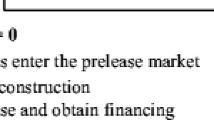Abstract
Subject to legal limitations, the owner of undeveloped real estate can determine both the date and density at which to develop his property. Alternatively, he can abandon his property. The value of these options depends partly on the stochastic evolution through time of the operating revenues and construction costs of developed property. In this paper the option pricing problem is solved analytically and numerically for the optimal data and density of development, the optimal date of abandonment, and the resulting market values of the developed and undeveloped properties.
Similar content being viewed by others
References
Anderson, J. “Property Taxes and the Timing of Urban Land Development.” Regional Science and Urban Economics 16 (1986), 483–92.
Arnott, R. and Lewis, F. “The Transition of Land to Urban Use.” Journal of Political Economy 87 (1979), 161–69.
Capozza, D. and Li, Y. “A Generalized Model of Land Conversion under Uncertainty.” Unpublished manuscript, University of British Columbia, 1989.
Capozza, D. and G. Sick. “Risk and Return in Land Markets.” Mimeo, University of Michigan, 1989.
Clarke, H. and Reed, W. “A Stochastic Analysis of Land Development, Timing, and Property Valuation.” Unpublished manuscript, University of Victoria, 1987.
Findlay, M.C. and Howson, H. “Optimal Intertemporal Real Estate Ownership, Valuation, and Use.” American Real Estate and Urban Economics Association Journal 3 (1975), 51–66.
Fischer, S. “Call Option Pricing When the Exercise Price is Uncertain, and the Valuation of Bonds.” Journal of Finance 33 (1978), 169–76.
Margrabe, W. “The Value of an Option to Exchange One Asset for Another.” Journal of Finance 33 (1978), 177–86.
Markusen, J. and Scheffman, D. “The Timing of Residential Land Development: A General Equilibrium Approach.” Journal of Urban Economics 5 (1978), 411–24.
Merton, R. “The Rational Theory of Option Pricing.” Bell Journal of Economics and Management Science. 4 (1973), 141–83.
Mills, D. “The Non-Neutrality of Land Value Taxation.” National Tax Journal 34 (1981), 125–130.
Shiryayev, A. Optimal Stopping Rules. New York: Springer-Verlag, 1978.
Shoup, D. “The Optimal Timing of Urban Land Development.” Regional Science Association Papers 25 (1970), 33–44.
Stultz, R. “Options on the Minimum or the Maximum of Two Risky Assets: Analysis and Applications.” Journal of Financial Economics 10 (1982), 161–85.
Titman, S. “Urban Land Prices under Uncertainty.” American Economic Review 75 (1975) 505–14.
Author information
Authors and Affiliations
Rights and permissions
About this article
Cite this article
Williams, J.T. Real estate development as an option. J Real Estate Finan Econ 4, 191–208 (1991). https://doi.org/10.1007/BF00173124
Issue Date:
DOI: https://doi.org/10.1007/BF00173124




